Discover the Best of Malta in Spring
Last Updated: Jan 28, 2024
Reading Time: 15 minutes
By: Shaun
Spring is a great time to visit Malta since the weather and temperature are quite pleasant and the island is less busy than in the summer. During this time of the year, you can not only explore the islands like you would at any other time of the year but also participate in some of the festivals organised during this time.
In this article, we will provide a guide to the top things to do in Malta in spring as well as some tips for visiting the island during spring.
Why should you visit Malta in spring?

Wied Iz-Zurrieq | Image by Andy Miccone on Flickr
1. Perfect temperatures
The weather in Malta during spring is generally mild and comfortable, with temperatures gradually increasing as the season progresses.
During March, the average temperature ranges from 12°C (54°F) to 18°C (64°F), with the sea temperature reaching around 16°C (61°F). While it may rain in March, the precipitation is usually not too heavy.
Temperatures start to rise in April, with the average temperature ranging from 14°C (57°F) to 21°C (70°F). The sea too starts to warm up during April, reaching around 17°C (63°F). April is a relatively dry month in Malta, with only a few days of rainfall.
The weather starts to feel quite summery in May, with average temperatures ranging from 18°C (64°F) to 25°C (77°F). The sea temperature continues to warm up, reaching around 20°C (68 °F), which starts to make it perfect for a swim. May is also a dry month, with only a few days of rainfall.
2. Avoid the crowds
The crowds are also smaller during the spring season, which means you can enjoy the island’s natural beauty and attractions without having to deal with long lines and large crowds that are typical during the busy summer months.
3. Its cheaper
The spring months are considered low season by the Maltese tourist industry. During this period of the year, many hotels airlines provide offers and various incentives to attract visitors.
What to do in Malta during the spring months?
1. Go diving
While diving in Malta is possible all year round due to its mild climate, the best seasons for diving are definitely winter and spring. During this time, the sea temperature would be around 15 °C. This time of the year is less busy than the hotter summer months, so you can enjoy the dives without worrying that they will get too crowded.
The Maltese islands are home to some world-class diving spots. Ranging from wrecks to caves and even sink holes, we list below some highlights.
Blue Hole
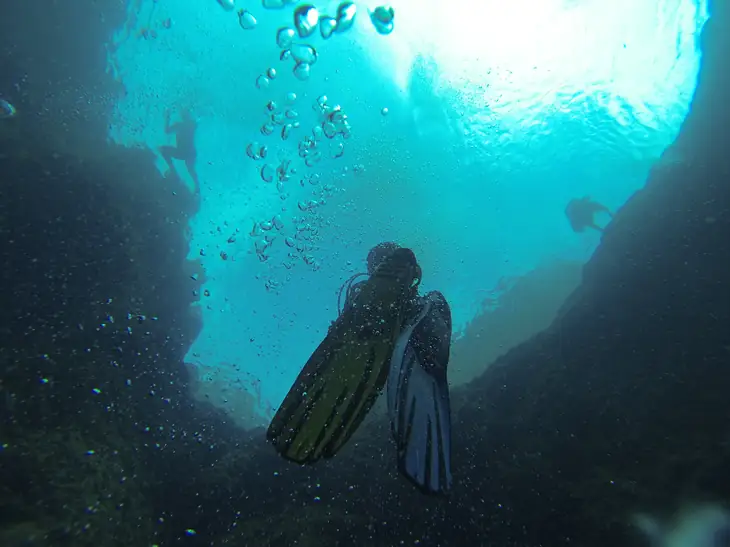
Blue Hole | Image by prilfish on Flickr
Located on the island of Gozo in the area known as Dwejra, the Blue Hole is a must-dive for any diving enthusiast. The site is a large underwater sinkhole that descends to a depth of around 60 metres and provides a unique and challenging diving experience.
Um El Faroud
The Um El Faroud is a sunken oil tanker that was purposely sunk off the coast of Malta in 1998 after it was involved in a tragic incident in 1995 while it was docked for repairs at the Malta Dry Docks. Today this wreck dive It is one of the most popular dive sites in Malta, and it offers divers the opportunity to explore a unique underwater landscape.
Santa Maria Caves

Santa Maria Caves | Image by Mick Long on Flickr
The Santa Maria Caves are located on the north coast of Comino, a small island located between Malta and Gozo. The caves are a series of interconnected tunnels and caverns that offer divers a great diving experience through their diverse marine life and amazing views of the surrounding sea at their entrances.
HMS Maori
The HMS Maori was a British destroyer that was sunk off the coast of Valletta during World War II by the heavy German air raids the islands suffered during the war.
The wreck can be easily reached from the beach, and it is the shallowest wreck dive you can do in Malta, with a maximum depth reaching only around 16 metres.
2. Go Hiking
There are many amazing hiking trails in both Malta Gozo, which give you a chance to explore breathtaking views of the sea and countryside. Here are some of the best hiking trails you should consider:
Dingli Cliffs to Blue Grotto

Church Of St Mary Magdalen at Dingli Cliffs | Image by user32212 from Pixabay
Located on the western side of Malta, the Dingli Cliffs are the highest cliffs on the island, with the highest point reaching well over 250 metres in elevation. From the Dingli Cliffs, one can walk about 12 kilometres south to reach the area on the outskirts of Żurrieq mainly known for the beautiful Blue Grotto.
Along the route, you pass by the Chapel of St. Mary Magdalene, some traditional Maltese farms, and spectacular views of the Mediterranean Sea and the island of Filfla.
Mġarr Round Trip
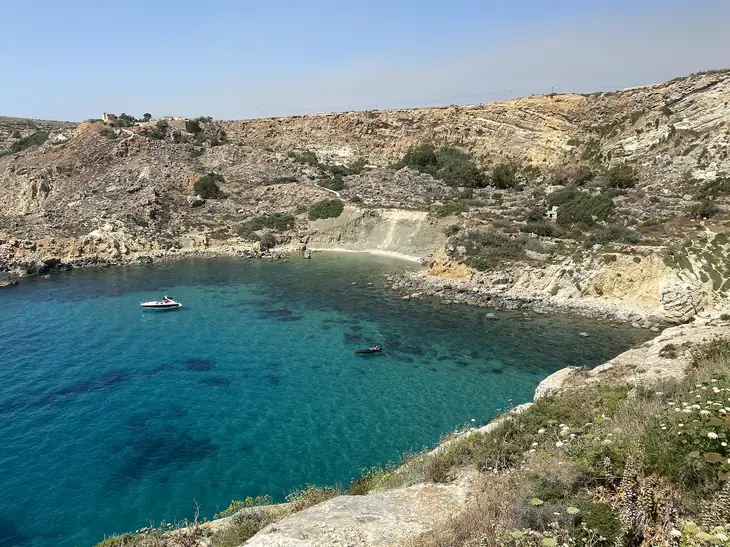
Fomm ir-Riħ | Image by MauiLizard on Wikimedia Commons
Mġarr is mainly known among the Maltese for the many restaurants that serve traditional Maltese food like rabbit and horse meat, but around this village, there are some great treks to witness the natural landspace of Malta.
Starting from the church of Mġarr in the centre of town, you proceed towards the coast to the beach of Ġnejna. After that, you turn south to Fomm ir-Riħ, before returning inland past the small, picturesque village of Binġemma before finishing it off where you started in Mġarr.
This trek is about 10 kilometres long, but it’s not too difficult and definitely worth the effort.
Mġarr ix-Xini to Xlendi Bay in Gozo

Ġgantija | Image by Kritzolina on Wikimedia Commons
Gozo, just like Malta, offers some amazing opportunities for some great walks and hikes. One cannot go wrong with the path from Mġarr ix-Xini all the way to Xlendi Bay. Between these two popular beaches on the island, one can walk along the impressive Ta’ Cenc Cliffs and Sanap Cliffs.
The walk is around 8 km long, and while much of it can be done following the marked footpaths, there will be places where you will need to deviate off the path to take a shortcut.
3. Visit the Historical Sites
Spring in Malta is considered the best season to visit the historical sites for several reasons. Firstly, the weather is warm and pleasant but not too hot, which makes it comfortable to explore the outdoor historical sites for a long stretch of time without needing to search for solace under some air conditioning.
Spring is relatively dry in Malta, with only a few days of rainfall, especially as you get into late spring. Finally, the sites would not be too crowded, which makes it much easier to explore and appreciate the sites without feeling overwhelmed or rushed.
Malta and Gozo have a long list of historical sites, with some highlights being:
The Megalithic Temples of Malta
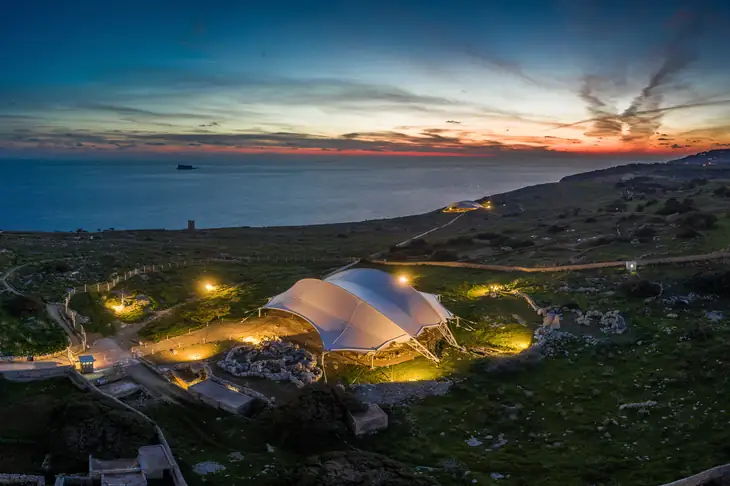
Ħaġar Qim and Mnajdra | Image by FritzPhotography on Wikimedia Commons
The Megalithic Temples of Malta are included in UNESCO World Heritage Sites and are among the oldest free-standing stone structures in the world. The temples date back to the 4th century BCE and are considered to be some of the most important prehistoric monuments in the world. Across the islands, one can visit seven temples, with the most accessible being Ħaġar Qim, Mnajdra, and Tarxien Temples in Malta and the two temples at Ġgantija in Gozo.
The Hal Saflieni Hypogeum

Hypogeum
The Hal Saflieni Hypogeum is another UNESCO World Heritage Site and is an underground temple that dates back to 4000 BC. The temple was discovered in 1902 and is located in the town of Paola. Visitors can explore the underground chambers and view the artefacts that make this temple such a unique and fascinating location.
Due to the site’s popularity and the restrictions imposed on the number of visitors to preserve the site, it is highly recommended that you plan your visit in advance and book your tickets once you decide on a date and time.
The City of Valletta

Valletta from the sea | Image by Bengt Nyman on Wikimedia Commons
The third entry Malta has on the UNESCO World Heritage Site is its own capital, Valletta. This city was built by the Knights of St. John in the 16th century after the Great Siege of Malta and is a testament to the architectural and cultural influences that the Knights left on the islands.
St. John’s Co-Cathedral, the Grand Master’s Palace, the War Museum, the National Museum of Archaeology, and last but not least, the breathtaking views of the Grand Harbour from both the Upper and Lower Barrakka Gardens. So make sure to allocate a day to explore this magnificent city.
The Three Cities

Senglea | Image by Jurgen Rekkers on Wikimedia Commons
The Three Cities are a group of fortified cities located across the Grand Harbour from Valletta and consist of Vittoriosa, Senglea, and Cospicua. They date back to the 16th century and are a reminder of Malta’s strategic importance during the time of the Knights rule over the islands. A visit to these cities will take you back in time to a period of history that shaped Malta’s culture and identity.
What to do in Malta in March?
Attend the Freedom Day Regatta

Regatta | Image by Maltese Traditions - Regatta on Wikimedia Commons
The 31st of March is a public holiday in Malta, commemorating the day when the last British troops left the islands in 1979. This was the final in a series of events that saw Malta transition from a British colony to the completely independent country it is today.
As part of the celebrations, a regatta is organised in the Grand Harbour and involves races between traditional Maltese boats. These boats are unique to Malta and are known for their distinctive shape and bright colours. There are seven regatta clubs in Malta, and on this day they compete in 11 races over a distance of just over 1 kilometre. Each race awards a number of points to the top 3 finishers, and at the end, the overall winner is awarded “The Shield” as a trophy, which they get to keep until the next year.
The regatta is always a highly anticipated event with the locals and draws large crowds to the areas around the Grand Harbour. For this event, the harbour is transformed into a festive atmosphere with food vendors, live music, and a carnival-like atmosphere. The regatta is organised again on the 8th of September, which is another public holiday that commemorates Victory Day.
Celebrate St. Patrick’s Day

Porte des Bombes on St Patrick's Night | Image by Joseph Psaila on Wikimedia Commons
St. Patrick’s Day (17 March) has become a real big deal in Malta over the last decade or two. The Maltese only need a small excuse to party, so when the Irish community in Malta started celebrating this holiday, it didn’t take long for it to become almost another national holiday, especially with the younger generation.
The celebrations are usually concentrated around Spinola Bay in St. Julian’s, where thousands flock to the area as early as 11 a.m. The Maltese didn’t hesitate to put a local twist on this celebration, and it’s very common to find locals as well as foreigners drinking Maltese beer like the internationally celebrated Cisk or the lesser-known Hopleaf or Blue Label Ale. Whichever drink you decide to drink, you cannot help but get involved in the dancing to the loud music that keeps on going till late at night.
If crowds and loud parties are not your style, then it’s best to stay away from the area on the day.
What to do in Malta in April?
Be part of the Easter festivities
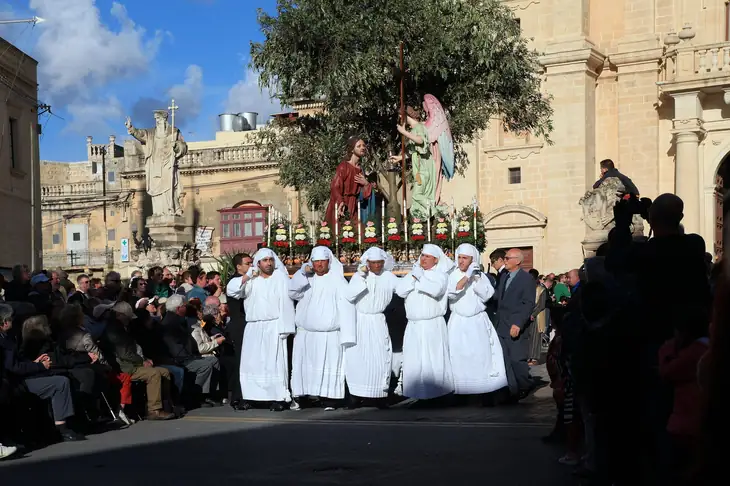
Good Friday | Image by Frank Vincentz on Wikimedia Commons
Easter is a significant religious holiday in Malta, as the majority of the population is Roman Catholic. The Easter celebrations in Malta are a blend of religious traditions and cultural customs that have been passed down through generations. In 2024, Easter will be celebrated on the 31st of March, with many activities happening in the week leading up to the holiday.
One of the most important traditions around Easter is the processions that take place in the streets of many towns and villages like Valletta, Mosta, and Victoria in Gozo, just to name a few. These processions are led by religious statues depicting the Passion of Christ, and they are accompanied by bands playing solemn music. Weather permitting, the processions take place in the evening of Good Friday.
Savour the Easter delicacies
During Easter, it is customary for the Maltese to gift each other a “figolla”. These are almond-flavored pastry cookies in the shape of various Easter symbols, such as lambs, bunnies, fish, and hearts. These cookies are often decorated with icing and candy sprinkles and topped with a chocolate egg. These “figolli” are widely available from supermarkets and confectionery shops across the islands.
Another sweet generally available during Lent (the 40-day period prior to Easter) are “Karamelli tal-harrub,” which translates as carob sweets. These are small sweets that appear like they are pieces of brown glass and are made from the syrup extracted from the carob tree.
Immerse yourself in the Mgarr Strawberry Festival

Strawberries | Image by slgckgc on Flickr
The annual Festa Frawli (Feast of the Strawberry) brings together local farmers, professional chefs, artists, and musicians in one of the most popular and anticipated culinary events in the Maltese calendar.
The festival will celebrate the sweet fruit with a feast of strawberry-themed snacks, desserts, jams, gourmet dishes, and beverages like strawberry wine. One gets to enjoy these treats in a family-friendly setting with a lot of entertainment for all ages.
The event is usually held in mid-April in Mgarr, and Heritage Malta too celebrates this event by opening up the two nearby megalithic temples of Ta’ Hagrat and Skorba at discounted rates, and guided tours will be provided during the day in both Maltese and English.
Attend the Malta International Fireworks Festival

Fireworks In Malta | Image by Meldarion Quesse on Flickr
If you’re looking for something that the Maltese take a lot of pride in and are good at, look no further than the Malta International Fireworks Festival, which is usually held at the end of April.
The festival gets held in various locations around Malta, like Valletta, Floriana, and the Grand Harbour. Each location offers a unique display, so it’s worth attending multiple events if this is possible.
Malta has a long tradition surrounding fireworks, and this festival provides a competitive platform for local artists to compete with international ones while showcasing their art to a large audience. You can expect to see a variety of different types of fireworks, including aerial shells, Roman candles, and ground-based displays.
What to do in Malta in May?
Attend the Valletta Green Festival
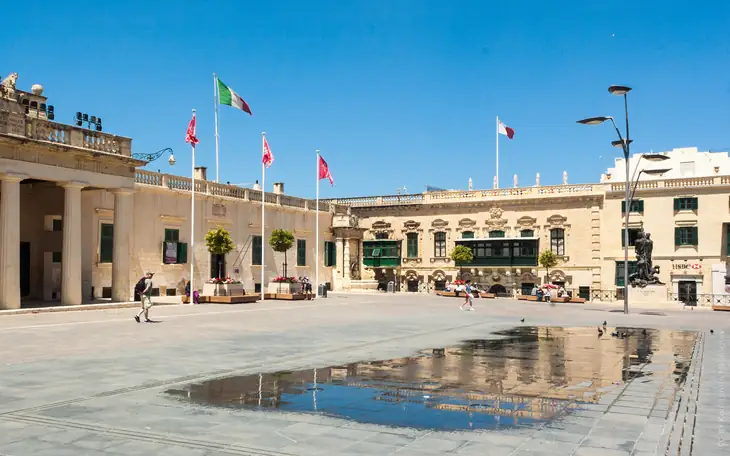
St. George's Square Valletta | Image by Konstantin Malanche on Flickr
The Valletta Green Festival is an annual event that celebrates environmental awareness and sustainable living in Valletta.
The highlight of the festival is the fantasy garden in Pjazza San Ġorġ, which features over 18,000 plants of all varieties and colours, creating a magical trail in one of the largest open areas in the city. The garden can be enjoyed by visitors of all ages, who can also participate in various activities and workshops related to nature, conservation, and green practises.
The festival also hosts several stands by different entities that promote environmental policies and initiatives in Malta. Visitors can learn more about proper waste management, environmental protection, green spaces, and resource conservation from these stands.
Additionally, one can also find several vendors that sell handmade, eco-friendly, and sustainable products.
At the time of writing the 2024 edition of the festival has not been announced yet, but it is expected to happen in May.
Visit the Gozo Spring Fair

Villa Rundle | Image by Wusel007 on Wikimedia Commons
The Gozo Spring Fair celebrates the spring season and the local culture of Gozo. The fair will take place between May 12 and 13 in the beautiful gardens of Villa Rundle in the centre of Victoria.
The fair offers a variety of attractions and activities for visitors of all ages, such as:
- Genuine, locally made goods to take home, such as crafts, food, and souvenirs.
- Flower arrangements and competitions, showcasing the creativity and skills of the participants.
- Children’s craft making and fun events, such as games, face painting, and storytelling.
- Music and entertainment, featuring local bands and performers.
The Gozo Spring Fair is a joyful way to discover Gozo during the spring and to enjoy its natural beauty, culture, and traditions.
Summer Lust 2024

Anastacia Live in Concert in 2015 | Image by Mark Kent on Flickr
One of the many festivals that happen in Malta throughout the years is the Summer Lust Music Festival. In 2024, the festival will bring two big names that need no introduction to the Maltese people. On May 17, the festival will welcome the renowned Italian singer-songwriter, Umberto Tozzi. As part of his Gloria Forever tour, Tozzi will for sure entertain the crowds with some of his iconic hits, which include “Gloria,” “Tu,” and “Ti Amo.”.
On Saturday, May 18, the American pop sensation Anastacia, whose recordings have sold over 50 million copies worldwide, will take the stage with an electrifying performance that will include hits like “Left Outside Alone,” “Sick and Tired,” “I’m Outta Love,” and “One Day in Your Life.”
The festival will be held in Ħal Għaxaq, a town in the south of Malta.
Conclusion
Malta is a great destination to visit in the spring, with its beautiful weather and variety of activities. Whether you’re looking for adventure, culture, or relaxation, Malta has something to offer everyone.
From hiking the Dingli Cliffs to exploring the capital Valletta or the Three Cities, there is no shortage of things to do in Malta in spring.
Frequently Asked Questions
What's the best way to get around Malta during spring?
The best way to explore Malta during spring is by renting a car or taking advantage of the island's public transportation system. You can also opt for a guided tour to see the sights.
Can I swim in the sea during spring in Malta?
Yes, while the water may be a bit chilly, it's still possible to swim in the sea during spring in Malta. Just be sure to check the weather and water conditions before taking a dip.
Can I still enjoy Malta's nightlife during spring?
Yes, while the nightlife scene in Malta may not be as lively during the spring season as it is during the summer, there are still plenty of bars, clubs, and restaurants to enjoy.
What clothes should I pack to visit Malta in spring?
When packing for your trip to Malta in the spring, consider packing light layers such as cardigans, light sweaters, and t-shirts without forgetting a light jacket for the cooler evenings. As the sun can be intense in Malta, don't forget to pack sun protection items such as sunglasses, a hat, and sunscreen.







